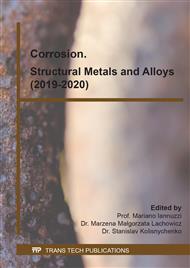[1]
V.N. Zhuravlev, O.I. Nikolaeva, Machine-building steel: reference book, Mashinostroenie, Moscow, (1992).
Google Scholar
[2]
V.V. Berezovskaya, N.V. Zvigintsev, V.A. Osminkin, Structure, Aging and Corrosion Properties of Fe-Co-Cr Alloys, Izv. universities. Ferrous metallurgy. 12 (1983) 81-86.
Google Scholar
[3]
M.D. Perkas, Structure, properties and applications of high-strength martensitic aging steels, // MITOM. 5 (1985) 23-33.
Google Scholar
[4]
Y. Asayama, Delayed failure and precipitation behaviour in maraging steels, Trans. Jap. Inst. Metals. 28/4 (1987) 281-290.
DOI: 10.2320/matertrans1960.28.281
Google Scholar
[5]
V.V. Berezovskaya, S.V. Grachev, V.B. Shirikhin, The initial stages of the decomposition of the supersaturated solid solution and the delayed destruction of martensitic aging steels, Metals. 2 (2001) 48-54.
Google Scholar
[6]
V.V. Berezovskaya, On the Nature of the High Propensity of Fe-Ni and Fe-Ni-Co-Martensitic Aging Steels with Titanium to Delayed Destruction, Metals. 5 (2003) 42-53.
Google Scholar
[7]
R. Lagneborg, Metallography of the 475 C Embrittlement in an Iron-30% Chromium Alloy, Trans. ASM". 60/1 (1967) 67-78.
Google Scholar
[8]
E.Z. Vintaykin, V.Yu. Kolontzov, Aging of iron-chromium alloys, FMM. 26/2 (1968) 282-288.
Google Scholar
[9]
G.R. Mihalishin, Age Hardening and structure of Iron-Nickel-Cobalt Alloys, Trans. ASM. 59/1 (1966) 60-70.
Google Scholar
[10]
Yu.A., Dorofeev, B.G. Lyashchenko, L.I. Novak, Neutron diffraction study of atomic-ferromagnetic superstructures FeCo: (Fe,Cr)Co, (Fe,Mn)Co and Fe(Co,Ni), Izv. Academy of Sciences of the USSR, ser. Phys. 30/6 (1966) 964-967.
DOI: 10.1016/j.actamat.2021.116668
Google Scholar
[11]
E.Z. Vintaykin, G.G. Urushadze, I.S. Belyatskaya, On the structure of magnetic alloys iron-crom-cobalt, FMM. 38/5 (1974) 1012-1015.
Google Scholar
[12]
A.F. Edneral, M.D. Perkas, On the role of cobalt in hardening when Fe-Ni is heated by martensitic aging alloys, FMM. 26 (1968) 5-12.
Google Scholar
[13]
V.M. Kardonsky, M.D. Perkas, High-strength martensitic aging steel with reduced cobalt content, MITOM. 6 (1968) 15-22.
Google Scholar



